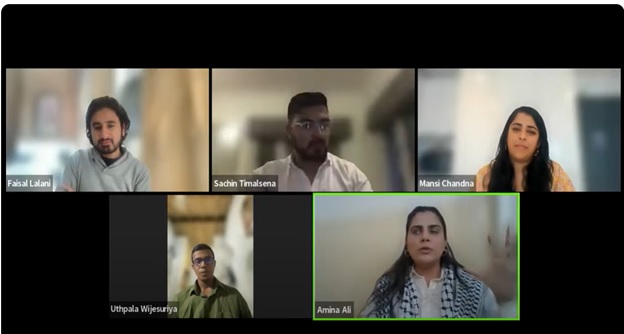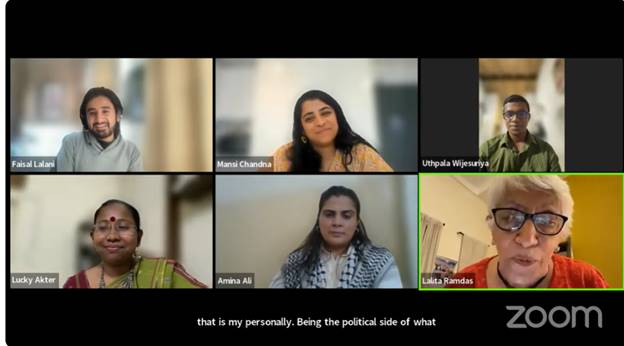
Exploring South Asian Identity and Diversity of the Youth, for the Youth, and by the Youth
By Naveen Akhund
Surrey, England
What does it mean to be Southasian? A versatile and passionate group of young people gathered at the Southasia Peace Action Network (Sapan) platform last month to explore this question.
This was the 24th session of the Sapan series, Imagine Neighbors in Peace, held on 28 April 2024, the last Sunday of the month as usual.
What came through strongly was their shared love of Southasian cuisine and cricket, an excellent icebreaker initiated by discussion moderator Faisal Lalani, founder of Thuley .
Researcher and founder member Sapan, Vishal Sharma, a PhD scholar from Shimla currently in Coventry, UK, hosted the event.
The lineup of speakers, all under 35 years old, and event organizers is online here
Mansi Chandna , joining from Manchester, talked about her grandfather’s experiences of being born and brought up in present-day Pakistan, and the migration to India as a result of Partition. She acknowledged and highlighted the trauma suffered by the Partition generation.
Originally from Jaipur, India, Mansi talked about how when she came to the UK for her Master’s in Peace and Conflict Studies, she felt isolated being one of the only visible brown people in her cohort, but her best friend now is a Pakistani and they celebrate Diwali and Eid together.
‘We are all South Asians and we have similar experiences.’ said Mansi, who works as the Monitoring and Evaluation Officer at the Forum for Discussion of Israel and Palestine.
Lucky Akter, a singer and activist from Bangladesh talked about the freedom struggle for Bangladesh and the crimes that Southasians have committed against each other in the aftermath of both ‘47 and ‘71. However, all is clearly not lost as she talked about how Southasians tend to flock to each other and unite when they are in a land foreign to theirs. She mentioned her time in Brazil and how she bonded with other Southasians which made her feel comfortable in her new surroundings.
She also discussed intersectionality as a Southasian. Some of us identify with our nationality first, our religion next, and finally our region and heritage, but when presenting ourselves to others, we may identify as Southasian first and foremost. Others may identify with their religion first, before everything else.
Amina Ali, a co-organiser at Aurat March in Lahore, Pakistan mentioned the ‘mixed-bag heritage’ which is something many of us are familiar with, our family trees being split up in much the same way as India was in 1947. Those who went through the Partition often speak of “the other side”, as their home. They talk about the differences in the food (we Southasians love our food!) with a slight competitiveness. ‘If you hear their stories, there is a lot of love, and there are very minor differences. They are very cute and stubborn about it,’ said Amina Ali fondly.
Another area Southasians love to compete with each other on is cricket, of course. Sachin Timilsina, the National Coordinator at the Youth Congress of Nepal and a cricket commentator and enthusiast, talked about how he would always side with India during cricket matches, despite the anti-India political climate when he was growing up.
‘My name is Sachin for a reason.’ said Timilsina, with a smile, referring to the famous Indian cricketer. Interestingly, he also mentioned that Nepal is the only country in South Asia which has an open border with India.
Sri Lankan historian and anthropologist Uthpala Wijesuriya, 20, commented on his experiences growing up in Colombo as well as rural Sri Lanka. He highlighted the importance of harnessing our diversity and culture as superpowers.
In the discussion section, Vidya Kakra in Boston, where she is doing her Master’s in Law at The Fletcher School of Law and Diplomacy at Tufts University, shared that she doesn’t have any family in Pakistan or Bangladesh. And yet, ‘we relate to each other because of shared culture, shared music’.
Hailing from Bombay, she said that her affinity towards Pakistan grew because of Coke Studio. ‘This is something that we, as the youth, should bring up more. We don’t know if the politics will ever be resolved, but as the youth of today it is our responsibility to take our similarities forward.’
Civil rights activist Tom Johnson who teaches history at UMass Boston commented that he saw the event as a ‘meeting of future South Asian cabinets, Parliamentary committees, distinguished heads of departments’.
He also suggested using the term ‘youngers’ instead of youth, as we use ‘elders’ and ‘seniors’.

Prominent Indian activist Lalita Ramdas (bottom right) shares the story of her daughter Kavita’s marriage to a Pakistani - Screenshot
Prominent activist Lalita Ramdas, one of the founding members of Sapan, shared a beautiful story towards the end about her daughter Kavita marrying a Pakistani, despite the family’s Indian military background. Lalita Ramdas is the daughter of India’s first Navy chief, Admiral Ram Dass Katari. Her husband, the late Admiral Laxminarayan Ramdas was slated to be India’s next Navy Chief in the 1990s, when Kavita told them about her relationship.
‘Of all the people in the world, our daughter had to find a Pakistani!’ he told his wife. Initially, they hoped it might be ‘puppy love’, something that would pass but the marriage is going strong 34 years later.
Southasia is a whole civilization that is more than a sum of all its parts. We can work together and influence each other. Above all, there will always be chai, cricket, biryani and Bollywood to bond over and bicker over!
As Mansi said, ‘All of this goes out the window when there is a cricket match.’
– Report by Naveen Akhund, Sapan volunteer and freelance writer based in Surrey, England.
Sapan News www.sapannews.com

